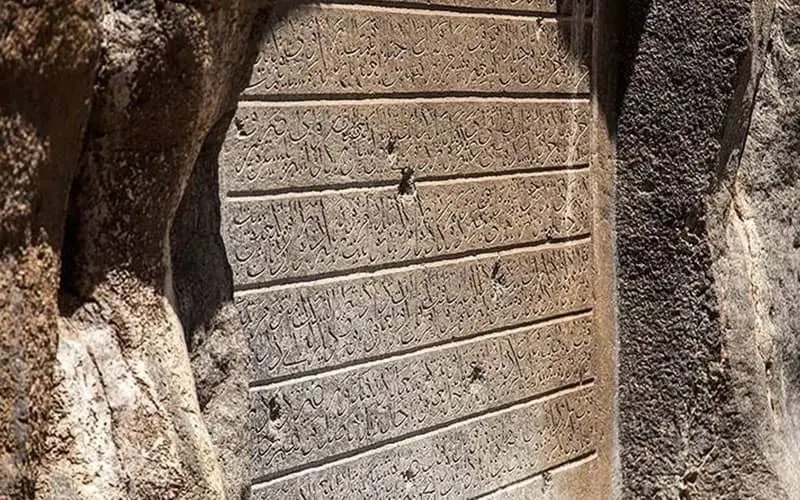The Castle of Medes
The monument of Medes Castle is located in the northwest of Mount Bestun and according to archaeological research in 1966, it had a tower and rectangle wall. The walls of the castle are made of fine and coarse stones. Because the artifacts found in this place are similar to the remains of Noshijan in Malayer and Godin Tepe in Kangavar, it is said that this castle belongs to the Median period. The discovery of a bronze hairpin dating back to the eighth century BC reinforces this possibility. In 2002, archaeologists found remains from different periods such as the Bronze Age, the Iron Age, the Achaemenid Period, the Ashkanid Period, and the Islamic Period; this proves that this castle was at its peak of prosperity and strength during the Median period.
Gudarz (Gotarzes) stone carving
The Gotarzes II stone carving is an Ashkanid monument that depicts the victory of Gotarzes II over Mehrdad. Mehrdad was an Ashkanid prince who grew up in the court of the Roman Empire. Gotarzes ruled the region from 38 to 51 AD. In this stone carving, which depicts a vague view of the battlefield, three armored warriors on horseback are said to be the central warrior, Gotarzes. In this scene, Nika, the god of victory, places a crown on Gotarzes's head while he attacks another rider, Mehrdad II, with a spear and knocks him off his horse. There is an inscription in Greek next to the carving that describes the battle of Gotarzes and Mehrdad.

Mehrdad's stone carving
The inscription of Mehrdad, one of the greatest Ashkanid kings, is one of the oldest remains of the Ashkanid kingdom. The monument dates back to 110 to 123 BC and is located just below the inscription of Darius the Achaemenid.
The stone carving shows the delegation of power by Mehrdad to the satraps (local rulers), each of whom stands in order according to his position. On the heads of each of the characters on the carving is an inscription in Greek script that identifies them. The first person is Gotarzes I, who succeeds Mehrdad. The name of the second person has been erased and may be one of the princes. The third person is Mithradates, who is identified in this inscription as "Pipis Tuminus," meaning "trusted by the king". The fourth person is Kufathates.
In addition to being damaged over time, this stone carving was partly destroyed during the reign of Sheikh Ali Khan Zangana, who was the prime minister of King Suleiman the Safavid, in order to make the inscription of Sheikh Ali Khan.

The inscription of Sheikh Ali Khan
Sheikh Ali Khan, who was the ruler of Kermashan and worked hard to rebuild the region, later became the prime minister of Shah Abbas II, and later Shah Suleiman of Safavid trusted him so much that they gave him the title of "trusted by the Sultan".
Sheikh Ali Khan's inscription is the text of Sheikh Ali Khan's endowment letter carved on the stone carving of Mehrdad II in the Bestun Mountain and destroyed some of the historical monuments of the Ashkanid period.

Shah Abbasi Caravanserai of Bestun
Shah Abbasi Caravanserai is one of the unique monuments of the Bestun Complex, located on the old road from Kermashan to Hamadan. The caravanserai, which covers an area of 6000 square meters, is built in the style of the caravanserais of the Safavid period. The construction of this caravanserai began by order of Shah Abbas I of the Safavids and was completed by the efforts of Sheikh Ali Khan, as shown by the inscription on the gate of the caravanserai.
This caravanserai was renovated during the reign of Naser Al-Din Shah Qajar and turned into a grain warehouse during the Pahlavi period. After the establishment of the Islamic Republic of Iran, it was imprisoned for 17 years and later taken back and restored by the Kermashan Cultural Heritage Office.
The caravanserai has four courtyards, two stone stages on each side, and seven brick towers, and four towers are built on four corners, of which only two remain. In 2014, it was decided to turn the historic monument into a traditional five-star tourist hotel that can accommodate 100 guests.

The Sassanid Bridge
Sassanid Bridge or Khasrow Parviz Bridge is 152.80 meters long on the Gamasiaw River and is located 2 kilometers from the city of Bestun. Looking at the construction techniques, how to carve the stones, and the marks left on the stones, it appears that this monument belongs to the Sassanid period and some experts believe that this bridge was part of the Sassanid Dam.
The bridge has 10 pillars and 9 arches with pillars 3.14 meters long and 2.70 meters wide. The pillars of the bridge are hexagonal in shape and made of a mixture of mud and carved stone. The bridge is built on a stone platform that both prevents the riverbed from washing away and regulates the water level. The bridge has collapsed and in recent years, iron pillars have been inserted on the stone pillars and an iron bridge has been built to replace the old bridge.

Bestun Bridge
Bestun Bridge is located on the Dinwari River and is known by several other names such as Shah Abbasi Bridge, Safavid Bridge, Old Bridge, Naderawa Bridge, and Dinwar Bridge. The bridge is 144 meters long, and because it was built at the end of the Sassanid period, it is said that it was built on the order of Khasrow Parviz.
According to research, the pillars of the bridge were built at the end of the Sassanid period, and like many Sassanid monuments in the Bestun complex remains incomplete and was completed in the 11th century AD, four centuries after the fall of the Sassanids. The fifth arch of the bridge was restored during the Ilkhani period and again during the Safavid and Pahlavi periods.









